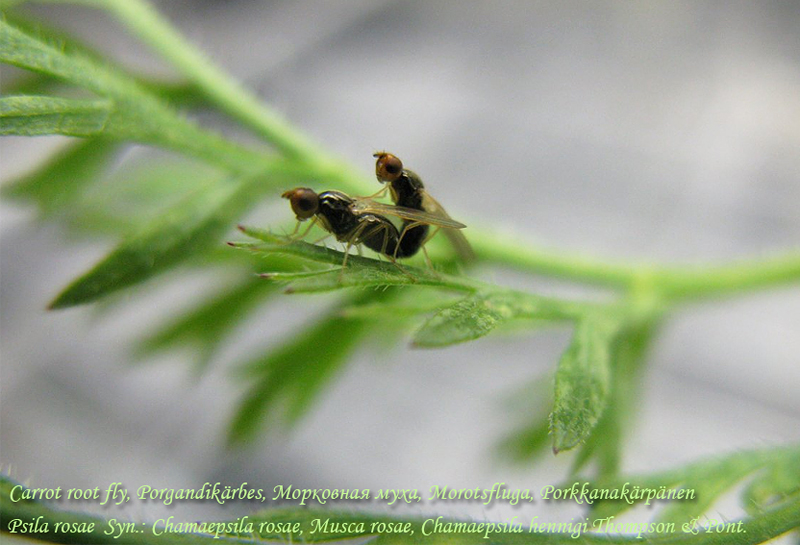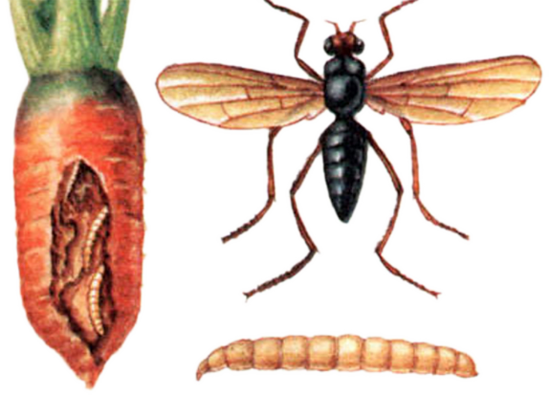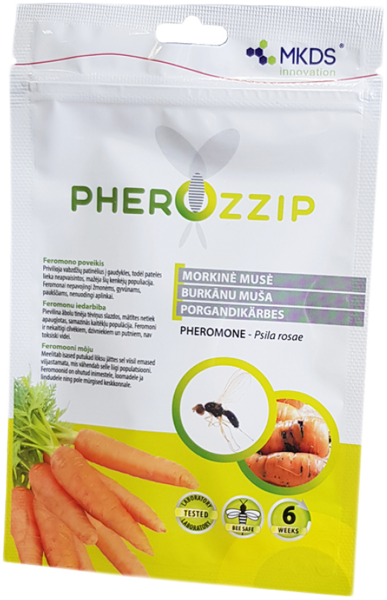Protect your carrots from the voracious larvae of this ubiquitous insect parasite!
Operating principle.
A bait - a dispenser is placed in a trap with an adhesive composition.
The dispenser contains a synthesized pheromone that attracts flies to the glue trap. Having flown into the trap, the flies simply stick to the surface of the "undying" glue.
* The pheromone of the female carrot fly does not attract other insects to the trap, since it is aimed specifically at attracting males of this particular species.
* The use of insect pheromones is allowed for widespread use in amateur and industrial gardening, since they do not pollute the environment and are safe for people, animals and beneficial insects.
* The synthetic pheromone trap perfectly plays the role of an indicator, allowing you to monitor the state of the garden for the presence of pests both in early spring and during the entire growing season of plants.
The product is safe for bees, humans and the environment.
The pheromone is effective for 4-6 weeks, after which its effect gradually decreases.

Household damage from carrot flies.
The larvae damage the flesh of carrot roots, parsnip roots, as well as parsley and celery. Sometimes found on the roots of dill and caraway seeds.
The larvae gnaw at the roots of young plants, after which they penetrate into the root crop itself, making rusty passages.
Damaged plants have bluish leaves, which then turn yellow and dry out, and the roots rot.
Control measures:
- compliance with the rules of crop rotation
- sowing in the optimal early terms
- removal of damaged plants during thinning
- use of mixed crops
- deep autumn plowing of fields after harvesting to destroy pupae of flies.
If the agrotechnical rules are not followed, the harmfulness of the carrot fly increases to extreme (then sprouting treatments with pesticides will be required).

Morphology and biology of the pest Chamaepsila rosae.
Fly 4-5 mm, shiny black with a greenish tinge, round head, rusty-yellow. There is a black spot around simple eyes on the crown of the head. Antennae attached under a slightly protruding forehead. Their third segment is dark with a bright yellow arista. The wings are wide, shiny with a greenish tint. Legs yellow, with elongated first tarsus segment. The abdomen is oval, small, folded wings protrude far beyond it.
The female lays eggs in the evening, placing them on moist soil at a distance of up to 0.5 cm from the carrot root or on the root under the root collar of celery plants. Fertility of the female is 100-120 eggs. The eggs are milky white, oval. With a massive appearance, females can lay up to 10 or more eggs per plant. Embryonic development lasts 4-17 days.
The larvae are cigar-shaped, pale yellow, shiny. The development of larvae lasts 2-2.5 decades, they pupate in the soil at a depth of 4-10 cm.
Flies of the second generation emerge in July-August, their larvae develop within 4-5 decades. Some of the larvae, along with damaged root crops, enter the storehouses, where they finish feeding in autumn or spring. They pupate in the soil at a depth of more than 10 cm, while puparia remain for the winter.
Features of the development of the insect.
It develops in 1-2 generations. The flight of the imago of the spring generation in the southern and middle lane begins in May during the flowering period of apple and mountain ash, in the north - in June.
Second generation flies appear in late July - early August.
The carrot fly is a moisture-loving and shade-loving insect that concentrates on shaded areas, near a forest or water body, as well as on thickened or heavily overgrown carrot crops, where high humidity is constantly maintained in the surface layer of the air.
Moderately humid weather and a temperature of +15.5 +17.5°С are the most favorable for the flight of these flies.
Syn.: Chamaepsila rosae, Musca rosae, Chamaepsila hennigi Thompson & Pont.












